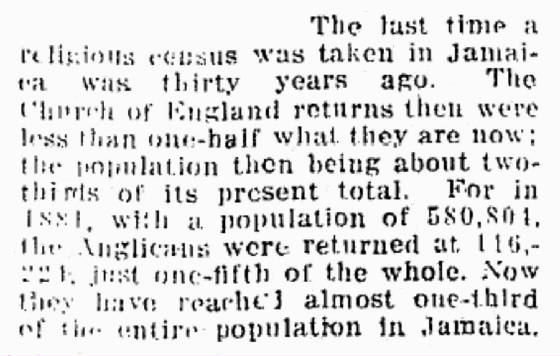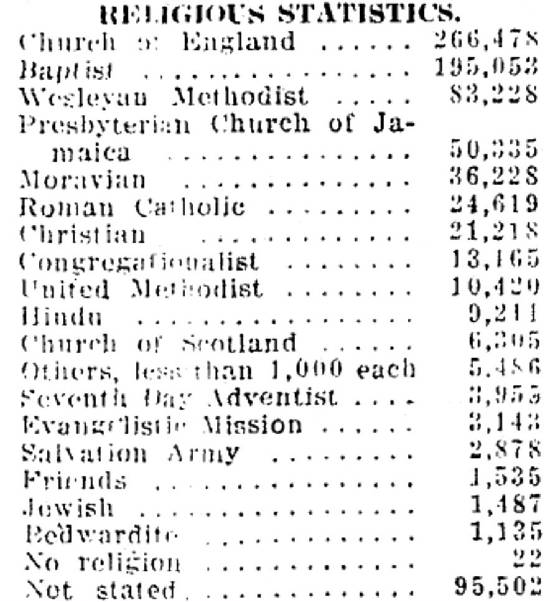Start | R Gordon | T Banbury | R O Taylor | C L Barnes | C C Douce | A Cole
other Black Anglican clergy | missionaries | other Black Anglicans
________________________________________________________
____________________________________________
Black membership of the Anglican Church in Jamaica
I have neither the time nor the resources to embark on an extensive enquiry into the numerical status of the Church of England in 19th century Jamaica, and its standing among the Black population. I will just set down here a few items which may serve as a counter-balance to the proposition that the Church of England was predominantly the church of the White population.
Speaking at a conference on church missions in Britain in 1894, Bishop Nuttall said:
In 1912 the Gleaner published the religion statistics abstracted from the census of the previous year; this comment was made on the change in the numbers of members of the Church of England compared with those 30 years before.

In 1900 a spokesman of the Church of England in Jamaica had assessed its position thus:

And these are the statistics of religious affiliation extracted from the 1911 census:

Country congregations:
Greater Britain Messenger
A service in a Jamaican church away back in the mountains is a revelation to a newcomer. Filled to the door with a congrecation as black as black can be, with the few white people of the district sitting in the two or three front pews, they crowd their churches with an intelligent, reverent and attentive body of hearty worshippers. . . . In these mountain churches they can have but one service on the Sunday, and many of the people have walked miles down the mountain paths to attend it.
more about the Colonial and Continental Church Society . . .
The Diocese of Jamaica
London: Society for Promoting Christian Knowledge, 1913.
from Chapter XII
Perhaps this is the most suitable place in which to say a few words on the connection of the Colonial and Continental Church Society with Jamaica. Before disestablishment this Society had helped to maintain Church of England schools, but had decided to make no additional grants, believing that the Jamaica Government would make sufficient provision for elementary education. In 1870, partly induced thereto by the late Rev. C. D. Marston, of St. Paul's, Onslow Square, a Jamaican by birth, the Society added Jamaica to its list of Colonial Dioceses, and has since that date regularly contributed towards the maintenance of four or five, and sometimes more, clergy. The Society's grants, being supplementary to voluntary offer, ings, have enabled the Church to continue her work in many a poor parish which otherwise could not possibly be self-supporting. The grants are not necessarily made to places, but to clergy, approved of both by the Society and by the Bishop, who can be transferred to other districts if their services are required without the grant lapsing; while on the other hand, in case of a parish beoming self-supporting, the grant can be transferred to a clergyman working in a district where it is more urgently needed. The continued and substantial interest taken by the Colonial and Continental Society in Jamaica has been of invaluable service, both in ordinary times and in times of crisis and disaster. Thus in 1897, when it was in contemplation that the grant should be annually reduced, with a view to gradual and complete withdrawal, the Society, bearing in mind the commercial depression then existing in Jamaica, agreed not merely to continue but to increase its help. So also in more recent years (1903 and 1907) special grants were made to meet urgent needs of clergy who had suffered by hurricane and earthquake. Neither the amount of the grant nor the proportion in which it is distributed is anything like enough to dispense with voluntary effort, but both are sufficient to enable work to be carried on and to prevent either individual distress or congregational collapse. The list of clergy who have been on the Society's list since 1870 is a very long one, but as most of them are still living and working I do not insert their names here.

